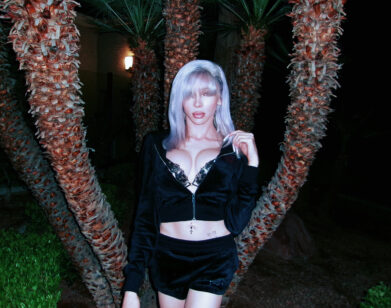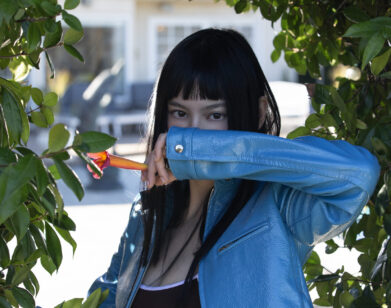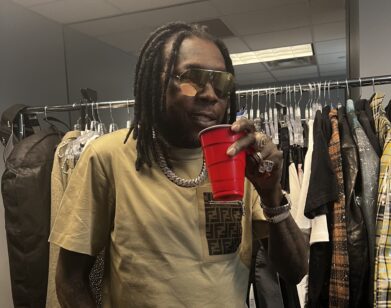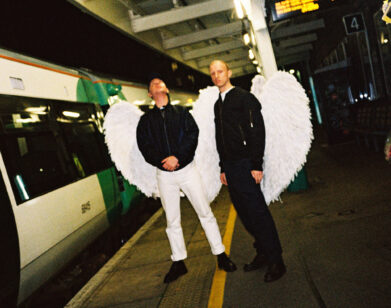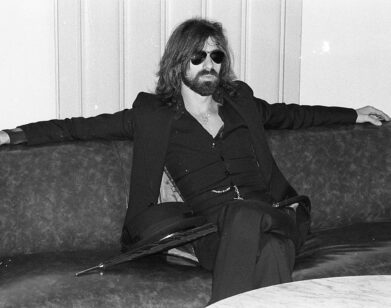Exclusive Video Premiere and Interview: ‘Free at Dawn,’ Small Black
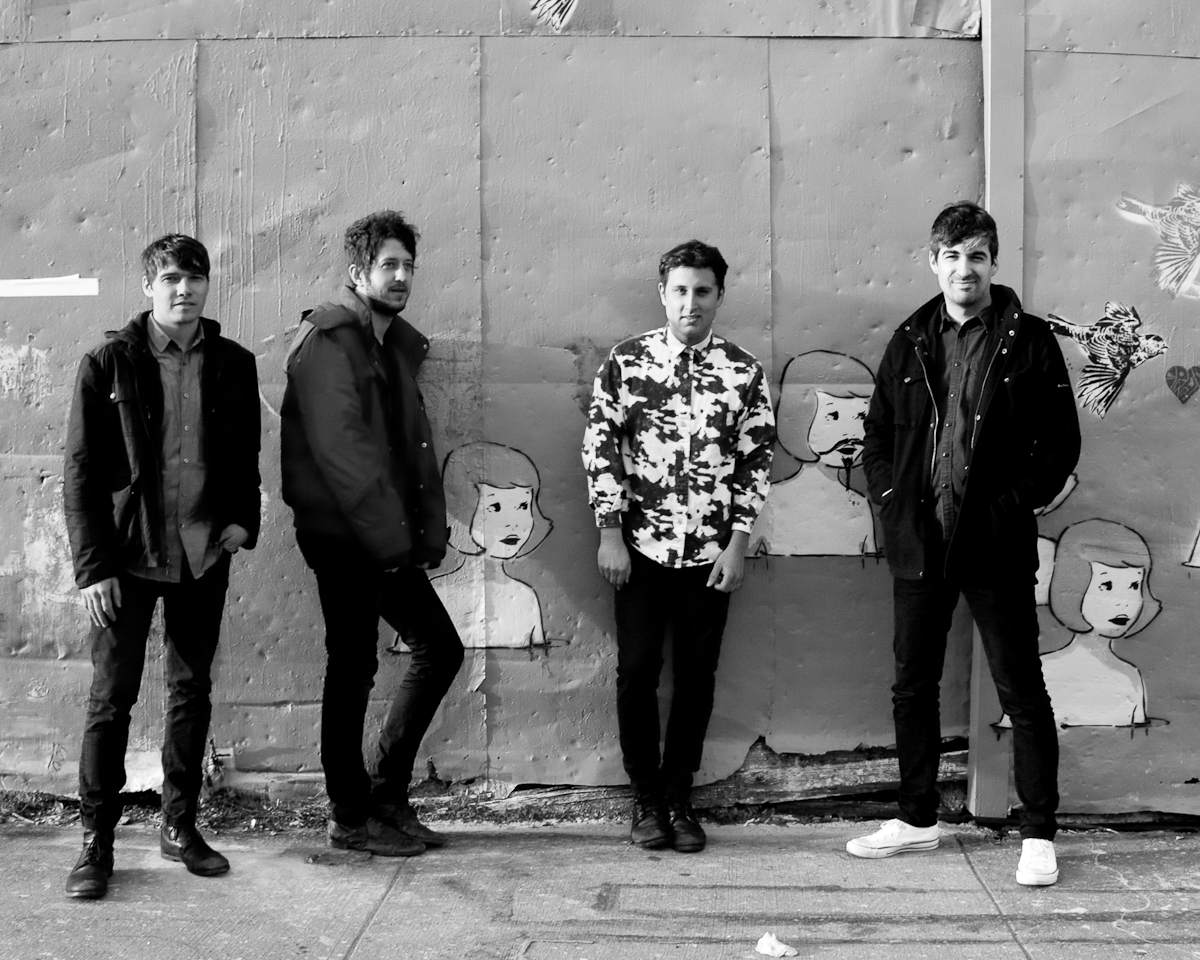
ABOVE: SMALL BLACK. PHOTO BY THEA GOLDBERG
Judging, at least, by the indie-rock videos of note released in the last month, it’s once again fashionable to write film letters to New York. Cat Power’s “Manhattan” trips winningly along the streets of Chinatown and the Lower East Side, and Vampire Weekend’s “Step” lyrics video, an homage to Manhattan, romanticizes the city as much as Woody Allen did 34 years ago.
In creating a video for “Free at Dawn,” the soaring and expansive opening cut from their upcoming album Limits of Desire, Brooklyn synth-pop quartet took a slightly different approach: though it, too, was shot on the streets of New York, director Yoonha Park took as inspiration Hollis Frampton’s 1970 experimental film Zorns Lemma, which features hundreds of words pulled out of the contexts of the street signs on which they appear.
Shot on 16-mm film, “Free at Dawn,” which we’re excited to premiere below, is both evocative and precise—a perfect introduction to Limits of Desire, which finds Small Black evolving beyond the hazy intimacy of its previous releases. We chatted with half the band, Juan Pieczanski and Josh Kolenik, about the video and the album.
ALEXANDRIA SYMONDS: I saw the show you played at 285 Kent to announce the new album, which felt like a good way to introduce that material. It really felt like the crowd was behind you guys.
JUAN PIECZANSKI: Yeah, it was a fun show.
JOSH KOLENIK: It was minorly terrifying, but I think it worked out in the end. [laughs]
SYMONDS: Why terrifying?
KOLENIK: I think any time you’re playing a bunch of new material for people, you just don’t know how it’s going to go.
PIECZANSKI: And we never played it live, so.
KOLENIK: Yeah. We played it one time the weekend before, so it’s the first time a bunch of people were seeing it.
PIECZANSKI: I think for eight of the songs, it was a debut.
SYMONDS: When a record sounds as big as Limits of Desire does, do you guys a prefer a place like 285 where you can fill it up with sound easily, or something larger?
PIECZANSKI: Well there’s a great vibe at 285 Kent, for sure. I think for what we’re trying to go for with the album, we definitely could use the benefit of kind of a bigger sound system and all that stuff. But we love doing those shows—the 285 Kent kind of shows, also.
SYMONDS: Do you have bigger spaces booked?
KOLENIK: We do, yeah. We’re playing Music Hall in June and yeah, it’s really nice to play good sound systems, especially for our band. It’s a lot of elements happening on stage, and a DIY venue can only handle so much, so we’re looking forward to it. I think it’s a lot of times a better show for the crowd even if it’s maybe not as big of a party.
SYMONDS: Where do you guys like to see music? Because you still live in Brooklyn, right?
KOLENIK: I mean, I like to go to 285, but… [laughs]
PIECZANSKI: Totally.
KOLENIK: But it’s more because it’s a fun party, and I get to see all my friends and figure out how to get in for free.
SYMONDS: That place is like Cheers. [laughs]
PIECZANSKI: It is. It really is.
KOLENIK: Yeah, you go to 285 and then you go to Daddy’s.
SYMONDS: I read a couple of other interviews you guys did about this album, and the fact that there is kind of a loose narrative to it. I wanted to talk a little bit about how the composition relates to that narrative. It opens so crisply and then ends in a kind of wandering way.
KOLENIK: Yeah, I think the last track, “Outskirts,” is meant to be a little bit of a departure and an exit from the world of the record to this sort of more vast and open space. The front-side of the record is kind of loaded with the more single-oriented material and the more easily structured stuff, and the second half is off-setting the simplicity of some of those structures at the beginning of the record.
SYMONDS: I think it’s interesting that the last few songs musically communicate a feeling of ambiguity without going back to the previous haziness or lo-fi quality that I think people who haven’t heard this album yet might still associate with you.
KOLENIK: “Shook Loves” is meant to be the climactic sort of point in the record. I’ve always meant those songs to feel like a really slow walk through New York at night. That vocal sample and noise sample that comes in at the end is meant to be very overwhelming and to overwhelm the track. These very beautiful and organic horns with this weird sound that’s kind of unexplainable and unexpected. It kind of leaves you cold in a way that I think is what we were going for.
SYMONDS: Yeah, I think that comes through.
PIECZANSKI: There’s definitely, musically, a vibe towards the end of the album that gets a little bit darker, a little bit more intense. For this song, we had so many different musical ideas. Having extra songs and extra music to work with really gave us an opportunity to give the album more of an arc, and to have that opening and closing and that shift in feeling toward the second half of the album. And that’s something that we haven’t really had the luxury of before—having so much extra material to kind of play with that arc.
SYMONDS: Was all the footage for the “Free at Dawn” video taken specifically for this video, or was some of it stock or archival footage?
KOLENIK: No, it’s all been shot in New York in the past month.
SYMONDS: How did the location scouting happen?
KOLENIK: Dave and I just went back and forth over email just talking about signs that we love, places that we loved and thought summed up our experiences living in New York. And, I don’t know, we just drive around in a car and set up the tripod and kept shooting whatever came to mind. A lot of it was planned—probably 75 or 80 percent—and then 20 percent of it is just chance and luck and finding stuff. I love having that, sort of, documentary angle to it. It’s always my favorite for videos.
SYMONDS: Was the process of making the video similar to the process of making your songs, in that you ended up with a lot of unused material, or did pretty much everything you shot make it in?
KOLENIK: Pretty much everything made it, because we shot on film, which is very expensive. Especially for the non-signage shots, there were maybe one or two alternate sequences that we shot, but it just cost so much that they brainstormed a great idea on how to be able to shoot on film and afford it. We had to work within those constraints, which is really nice, because shooting hours and hours of footage and then having to sift through it is… it gets old. I think it’s nice to be forced to get the shots you need to get and not be able to screw around.
SYMONDS: I also wanted to chat briefly about the Moon Killer mixtape, which is terrific. How did you and Heems come together?
KOLENIK: We actually met Heems at a show in New Orleans. He just showed up.
PIECZANSKI: With guys.
KOLENIK: We didn’t know they were fans and they came over and were hugging us and were like, “We love you guys.” Like, what? We had no idea. But it turns out our friends in Bear in Heaven had turned those dudes onto us and they were fans and I don’t know. We just caught them in New York a couple times and we had Heems over just to have some pizza and do some songs.
PIECZANSKI: The first time I met Heems in New Orleans, I never met him and he just comes up to me out of nowhere, just darts right to me, and gives me this big, giant bear hug. [all laugh] I’m like, “Who is this?” And I recognized him. I’m a fan obviously, we’re huge fans of them and I was just like, “This is crazy.” So it was a really crazy night.
KOLENIK: That city kind of always leads us to some insane party or some late night wildness. So it’s par for the course.
PIECZANSKI: Yeah, we love it.
SYMONDS: Do you ever play that Kate Bush cover live?
PIECZANSKI: Not really, because we don’t have Heems to do it We did it once when we had Heems in town. I don’t know, I don’t know if it would work.
SYMONDS: But it’s just the little snippet of it in that song—would you ever cover “The Big Sky” in full?
KOLENIK: Oh, I don’t know. Yeah, I love Kate Bush. I hadn’t considered it but, yeah, that would be fun.
PIECZANSKI: We’re glad you picked up on that. Nobody mentions Kate Bush.
KOLENIK: I mean, that was the whole reason to do the mixtape—to just make sort of overt references to people we love and music we love, and people just didn’t know it. There was lots of other stuff too. There’s tons of huge samples on the record that were never mentioned in the press anywhere.
PIECZANSKI: Yeah, no one picked up on it.
KOLENIK: Like, that song “Clear Blue Skies” is a sample of this late ’90s underground New York rap hit. It’s the same name, by this group called the Juggaknots, and not one person picked up on it. It’s pretty obscure, but I named it the same thing on purpose just to make it really obvious.
SMALL BLACK’S LIMITS OF DESIRE IS OUT MAY 14 VIA JAGJAGUWAR. FOR MORE ON THE BAND, VISIT THEIR FACEBOOK PAGE.

